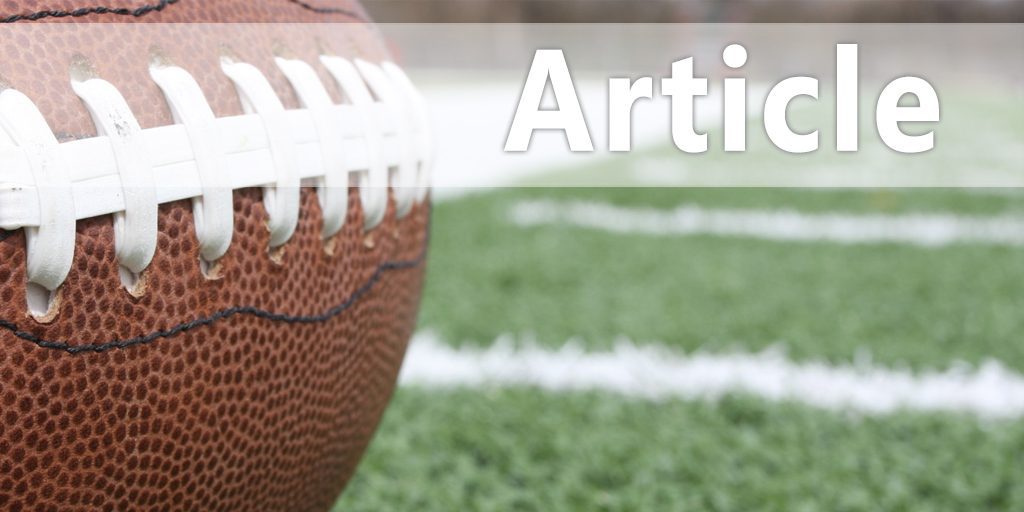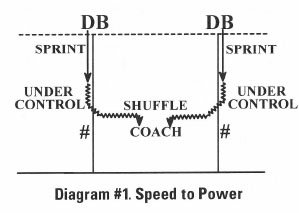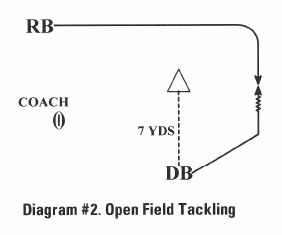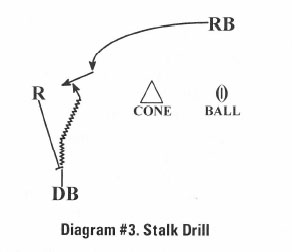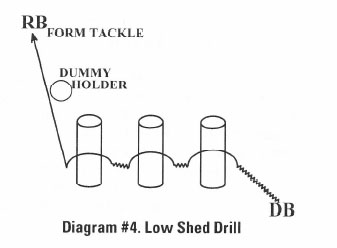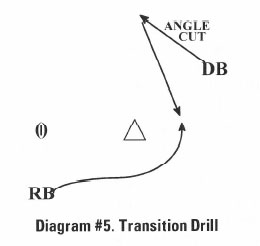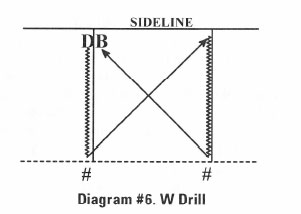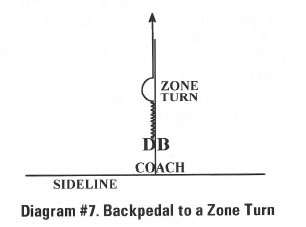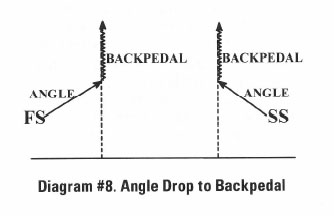|
Defending the Spread Offense
Thank you. It is a pleasure to be back in this area. It was funny when Coach Meyer told me that I did not have a recruiting area in Ohio. He told me my recruiting area was North Carolina, South Carolina, and Georgia. I thought, "Here we go again, battling the SEC and the ACC for all the athletes." I am very fortunate to be a part of the staff at Ohio State. It is a great staff. It is fun to walk into the defensive room every day and see Luke Fickell and Mike VrabeL It is great to bounce ideas off those coaches. Luke and I went through the same thing last year as interim head coaches, and Mike has three Super Bowl rings. It is fun to go in there and talk football every day. We feel like we have many good things going on at Ohio State. What I want to do today is give you some insight into what we look for in a high school athlete. I also want to talk about some of the drill work we use to get players ready to play. I am going to coach the defensive backs at Ohio State and focus on the safeties. We will have a corners coach, and I will tie it all together there. I want to talk to you about defensive back philosophy and fundamentals. However, I want to start talking about what we look for in athletes at Ohio State. I always talk about core values. That is one of Coach Meyer's big things. The core values are non-negotiable at Ohio State. Either a player has these cores values, or he does not play at Ohio State. Coach Meyer talks to the entire team about core values, and we talk to the individual players about them in our position meetings. When I go into a high school and talk to the head coach about a prospect, I will ask some frank questions about the player. I will ask the coach if he smokes marijuana, whether he smokes dope, or uses any kind of drugs. We do not want a dope smoker in our program, and I will ask the coach if he does. There are certain things I am going to ask, and I am going to give you several of them right now. Core Values • Competitive excellence I want to know if he will compete. You will know when I come into your office what I am going to ask. Is he a competitor? As a defensive back, will he fight every day to be the best defensive back he can be? Will he fight in the classroom? I talk about grinders in the classroom. The player does not have to be a 3.0 GPA student in the classroom. He can be a 2.4 or 2.3, but he grinds every day in the classroom. He hangs in there and works with his teachers trying to get it done. I have seen a bunch of those types of players, and I love them. I was that kind of student, too. We talk about competitive excellence at Ohio State. We want to know if the player has the tools to win when we call his number. We want to know if the defensive back has the tools to stop the best receiver on the opponent's team in a critical situation. Does he have the tools and competitive excellence to go make the play and win the game? We want to find out if we have a competitor. Does he like the war? Does he like the preparation it takes to get into the war? We want a competitor who will accept the challenge of playing in the intensity of the game. We want a player who is a communicator. When a player comes to junior day, if I have not had any previous relationship with the player, I probably will not know much about him. Even though I may have watched high school tape, I will not know much about him. However, I am going to sit down and talk to him. I want to sit down and see if he will talk to me. I want to see if he will look me in the eye and communicate with me or will he hang his head and mumble. There is one thing I know about defensive backs. If they cannot communicate, the other team's band is going to play after the score. It is essential for the defensive backs and linebackers to talk and communicate on every down. Those players have to communicate and have some personality. The other aspect of communication is the player talking to his teachers in the classroom. If a player makes a bad grade on a test or paper, he has to immediately talk to the teacher and get the situation corrected. They have to get the classroom going in the right direction. They cannot wait until the end of a semester to try to correct a problem. These players have to take the initiative and verbally get things done, I think this is important in the core values of a person. We look for players who are students of the game. How many of you coaches are in your school all day? If you are in your school all day, you get the chance to see your players each day. You have the chance to work with their class schedules. However, we have boundaries with respect to the amount of time we can spend with our players. If a player does not come in on his own to study the game, it will be hard for him to be successful. We get our players for 20 hours a week. In the off-season, we get them for eight hours a week. In most cases, the strength coach wants them for those eight hours. When does the player have time to watch game film, technique tapes, cut-ups of his position, and related films? He must come in on his own and be a student of the game. If he treats preparation as his high priority, he will be successful. If he gets himself ready to play, that will be the most important thing he can do as a football player. He can do that before he steps on the field. The day of the player showing up and dominating is over. As you go to the higher levels of our sport, many players can play the game. The edge for the player is to be a student of the game and be prepared to handle the teaching involved with the game. We look for players who actually like the game. I have used this for the last 15 years of my coaching career. In the game of football, the ball is the issue. I want one player on defense who understands that the ball is the issue. He is the player who finds a way to be around the football. If they throw it or run, it, he is around the ball. He is breaking up passes or intercepting them in the secondary. He makes tackles at the point of attack. He attacks the ball. When I talk about defensive backs, I do not simply mean safeties. I am talking about the corners also. I want corners who will attack the ball. I am not one of those coaches who says corners do not tackle. At the defensive back, we must have players who are productive players. As a defensive coach, we grade our players. A player may play only eight plays out of 65 plays on the tape. We want to know what he did on those eight plays. We want to know if he affected the game in the eight plays. If he was in a position to make a play, did he make it or not? You must know who is making plays for you. If a player plays 30 plays, he must do something. He may not make any mistakes in assignment, but if he is not making plays that affect the game, he is not productive. We are in the off-season program right now. We are looking at the players in that program. We are in an evaluation-friendly profession. We have a deal in the off-season called "win or lose." The deal is whether the player was whipped or not. There are eight drills with points assigned to each one. There are not degrees of defeat. Were you whipped or not? We evaluate the drills and post the results. One player goes against another player. You cannot argue the results because we arrive at the results by a point total. We can make this thing more than it is. We can find out who will compete, fight, and attack. You must put some form of measurability on them to declare a winner. You can measure production. If you can get a player on your campus and in your program who does not know his statistics, I do not want him in my room. I want the players who know how many yards they ran for or how many interceptions they had. They can tell you and are proud of the fact. We want these qualities in the players we recruit. I want to get into some drills. There are coaches who like X's and O's, but I am a fundamental coach. You can put X's and O's anywhere on the paper. If you do not play with fundamentals, none of the X's and O's in the game matter. I am not a guru with all the answers. I am a fundamental coach. We talked about this in our defensive meeting yesterday. What is the most important thing a defensive football player has to do? If you listen to all the talking heads on ESPN and the numerous sports shows, they have all the answers. The most important thing in defensive football is tackling. If you cannot tackle, you cannot play defense. You have to teach tackling, and you have to start teaching it now. You have to teach it every day. You can practice tackling every day without even hitting the players. Tackling is about body position and putting yourself in good position to tackle. I am going through some drills that will help you teach young men to play. We do a drill we call speed to power tackling" (Diagram #1). This drill is relative to where the defensive backs play. The players align at the hash marks five yards apart on a yard line, and the coach is at the numbers. The coach starts the drill with a movement. The players sprint toward the coach to get in position. The sprint part of the drill we call speed.
The coach makes another move that signals the players to come under control. The players come under control, gather their feet, and get into a fundamental football position. We call this the power stage of the drill. In the power stage, you sink the hips, get all the cheats in the ground, and start shimming the feet. You get the chest over the knees and knees over the toes. That puts you into a position to tackle. The coach makes the final move with his hands, and the players shuffle into him from each side. They do not cross their feet, and they keep their shoulders square to the coach. You can do this drill every day you have your players. It does not require any equipment. We conduct this tackling drill because the defensive backs must master it. This is an open field tackling drill (Diagram #2). We place the cones to represent a running back. The defensive back uses the speed and power drill to get into position on the running back. When we do this tackling drill, we look for the fundamentals of tackling. We do not want them to cross over with their feet as they come under control. We do not want the feet to come out of the ground very far. We want to keep the pads square on the ballcarrier. A good running back will attack the leverage of the tackler when he gets his feet out of the ground or crosses over with them. The running back will take advantage of that and break outside.
The tackler mirrors the speed of the running back. The tackler uses the speed stage of the drill when the ballcarrier is using speed. When the ballcarrier slows his speed to make a move on the tackler, that is the time the tackler comes to balance and gets his pads square with the ballcarrier. The tackler wants to run fast in the speed stage. He comes to balance and gets under control in the power stage. To make the tackle, he must have his pads square with the ballcarrier. He wants to keep his feet close to the ground and squeeze the ballcarrier. On a field turf field, you should see the small rubber pellets coming out of the ground from the shimming of the tackler's feet. In an open field tackle, the tackler does not want to get his chest or shoulders too far over the knees. The tackler in the open field wants to stay higher and show his chest. I want the tackler to be vertical in his approach to the ballcarrier. If a linebacker is playing downhill and filling into his fit, his shoulder and lean can be more forward and more bent over the knees. That is because the linebacker works in a tighter space with more traffic. It is the opposite for the defensive back. He tackles in space and must be able to move from side to side. He cannot do that with his weight too forward. The next thing we talk about with the defensive backs is leverage. Defensive backs have to get off blocks and make tackles. They have to understand leverage and how to keep it. Leverage plays a role in the running game as well as the passing game. The defensive back has to know his run fit is the running game. We work block escape and getting off blocks every day in practice. • Tackling At the beginning of practice, we do drills called development drills. The development drills are drills we work on daily. In the block escape drill, it is all right to rep the hand placement and pad level in a fit or dummy drill. You have to learn that first. We do those drills at the beginning of practice. We work them against a one-man sled. We work on the punch, lock out, shed, and tackle. The defensive back punches the one-man sled and gets his hand placement on the dummy. He locks out and lifts the sled as the second part of the drill. He disengages and makes his rip move to the outside of the sled and performs a form tackle on another player. However, you must do these drills live at full speed to learn how to play blocks. You must do live stalk drills against the receivers. In the stalk drill, the defensive back must have his hands up and into the receiver's chest (Diagram #3). We want the thumbs up and the hands inside the receiver's hands. We The defensive back has to engage the receiver, stun him with a punch, violently disengage by throwing him across, and make the tackle on the ballcarrier. When we do this drill, the live part of the drill is the disengagement of the block followed by a form tackle at the end. The low shed drill simulates the beginning of a play (Diagram #4). We align three small bags on the ground. The defensive back steps over the bags and gets ready to take on the blocker. We tell them to dip and rip. You need a dummy holder with a pad so the defender can dip and rip through the outside of the blocker. After he gets past the blocker, he has to square back up to prepare for the tackle.
The situation the defensive back can encounter is an offensive tackle as a lead blocker with the running back eight yards behind him. If the defensive back takes on the offensive lineman, it is like an elephant taking on a mouse. If the defensive back uses the dip and rip technique, the offensive lineman will never block him. They cannot get that low to block the defensive back. The defensive back gets his pads under the pads of the blocker, gets low, plays up, and squares his shoulders. The finish to this drill is the tackle. There are two ways to finish the drill. You can strike, wrap up, and drive the ballcarrier back, or you can do the same thing and take the ballcarrier to the ground. The object of the drill is to dip and rip under the blocker instead engaging the blocker, who outweighs him by 150 pounds. The defensive back has to make plays out of his transition (Diagram #5). We started this last Thursday in our off-season program. This skill is a defensive back breaking into coverage with a coverage drop. We hand the ball off, and the defensive back has to transition from his drop into an attack mode and make the tackle. The problem the defensive back has is there is space on either side of the ballcarrier. He has to make a tackle in space. The first thing he has to do is get his chest out and not get top heavy with his posture. He has to pin a hip of the ballcarrier. He cannot square up on the belt buckle of the ballcarrier. If he does that, he gives the ballcarrier two ways to go. We want to give the ballcarrier one way to go. To do that, the defensive back has to pin a hip of the ballcarrier. To pin a hip means the defensive back attacks with outside or inside leverage and forces the ballcarrier to go only one way. When the defender does that, he has to know where his help is. If he has the rest of the defense pursuing from the inside, the defensive back pins the outside hip of the ballcarrier. That sends the ballcarrier back into the pursuit. If the ballcarrier is too far away from the pursuit and close to the sideline, the defensive back pins in the inside hip and makes the ballcarrier break to the sideline. That way, the defender uses the sideline as the pursuit and drives the ballcarrier out-of-bounds. The transition drill is the same drill we did in beginning, except the ballcarrier can cut both ways. We do not take the ballcarriers to the ground, so there is no one being hurt. You can do this drill every day. You can do this drill in a gym. The defensive back has to close the ground between him and the ballcarrier as quickly as he can. In the drill, the defensive back wants to get under control, pin the hip, shuffle the feet, and squeeze the ballcarrier. As the ballcarrier breaks, the shuffle is to get the tackler's shoulder square. The defensive back wants to shuffle the feet into the tackle. If he crosses over with his feet, there are no power angles left in his knees and ankles. If he crosses over with his feet, he has lost the ability to make a play if the ballcarrier breaks the opposite direction. The tackler can put his head across the ballcarrier once he makes his final break and attempts to get by him that way. Until that time, the tackler wants to stay square with the ballcarrier. That includes the speed part of the drill. As the tackler closes the distance between the ballcarrier and him, he keeps the shoulders as square as possible. If the ballcarrier tries to cut back on the tackler, he can press him immediately and make the tackle. If the tackler shuffles and the ballcarrier tries to cut back, the defender can plant his outside foot in the ground and attack him. If the tackler crosses over, he cannot make the tackle on a cutback run. Spend time getting your players into positions they will encounter in a game. Do it with a number of different drills teaching the same things. You have to practice those positions. When you teach players to backpedal, you must teach safeties as well as corners. When we talk about backpedal, we tell our players that the transition from backpedal to a forward move on the ball is what leads to their chance to play at the next level. If they want to make some money, they must learn this skill. The difference between the players who make it in pro ball and the ones who do not is the transition. I am a two-step coach. We have a plant step and a drive step. When we backpedal, we want the feet brushing the ground. We want them close to the ground and not off it. If the defensive back wants to break to the left, he plants his right foot. He wants that foot planted at a 45-degree angle to the inside. That allows his hips to open to the left. He gets his left foot on the ground and breaks at a 45-degree angle. There are seven cleats on the bottom of the average football shoe. When he plants his foot, we want all seven studs in the ground. He cannot be on his toe. We say that every day. We want all seven cleats in the ground. I am a two-step coach. We have a plant step and a drive step. When we backpedal, we want the feet brushing the ground. We want them close to the ground and not off it. If the defensive back wants to break to the left, he plants his right foot. He wants that foot planted at a 45-degree angle to the inside. That allows his hips to open to the left. He gets his left foot on the ground and breaks at a 45-degree angle. There are seven cleats on the bottom of the average football shoe. When he plants his foot, we want all seven studs in the ground. He cannot be on his toe. We say that every day. We want all seven cleats in the ground. The defensive back cannot think about his footwork when he tries to cover a receiver. It has to be ingrained and second nature. We rep the movement so it becomes second nature and something the defensive back does not have to think about as he transitions on a break. When we transition from backpedaling to the drive, we want the drive foot in front of the body, not under it. If it is under the body, the defensive back has lost a step. We want a positive step to the target. We teach the plant and drive steps in a W drill (Diagram #6). We work the drill off the sideline. The defensive back starts facing the coach at the sidelines. On movement, he backpedals down the yard line. When he reaches the bottom of the numbers, he transitions and drives back to the sideline at a 45-degree angle. When he reaches the If the defensive back has to gather himself as he transitions, his weight is too far back in his backpedal. The transitions of the weight should not cause the defensive back to stop his momentum before he changes direction. His transition should be constant and fluid. The second thing they have to do is keep their eyes up. You cannot let the defensive back drop his eyes to look at his feet. The eyes of a defensive back control everything he does. You can do this drill anywhere. You can do it in the gym or on the grass. You have to give defensive backs tools to put in his toolbox. The angle cut is one of those tools. One of the things any defensive player has to learn is to keep his shoulders square. If the defender can play with his shoulders square, he can go in a number of different directions. In the last two weeks, I discussed the technique of bailing out of coverage for the defensive back. If a defensive back is in press coverage, he sometimes bails out of that coverage. That means he opens his hips and runs out of the coverage. When the receiver breaks off the line of scrimmage running vertical, he can break in any number of directions. If the defensive back opens his hips on the bail out, he can only be efficient on the inside cut. He cannot stop the speed-out or the comeback to the outside. As long as the defensive back stays square, he can play both outside and inside on breaking patterns. The technique of playing defensive back is trying to stay square as long as possible. The defensive back cannot stay square if the receiver is going to run by him. In that case, he has to open his hips and run. When we talk though this part, I want to talk about angle cuts. If the safety has a quarter read from the #2 receiver to the #1 receiver, he has to stay square. If the #2 receiver runs to the flat and the safety turns his shoulders to the flat, he gets beat on the post cut of the #1 receiver. If the safety can angle cut and keep his shoulders square, he can play the entire route combination. This skill is to angle cut and transition to keep the shoulders square. In the footwork of the defensive back, we want to be efficient with every angle or move we make. When you teach footwork drills, you cannot go at full speed from the start. You must slow down the drill and let the players get comfortable with what they are doing. An important thing for the defensive back to do is to be able to control his backpedal. Some backs have only one speed in backpedaling. They go as fast as they can. If they try to slow down, they are too slow. The ability to control the speed is a plus, especially deep into the field. When a defensive back can control his speed, he can speed up or slow down, and nothing changes with the upper body. It all has to do with controlling the revolutions in the feet. While backpedaling, the defensive back eventually has to turn and run (Diagram #7). We teach this on a line. We backpedal and hip-turn into a running position, running along a line. When we teach this part of the technique, we teach pulling the elbow to the side of the turn through to get the hips turned the other direction. When we open the hips to the right, the right elbow has to pull hard to get the body to start to turn. As the hips open to the right, the left knee has to move inside to unlock the hips. When we do our drills, we do everything on a line. When we open the hips, we want the left foot to be back on the line as quickly as we can. To open the hips to the right, we press the right toe, throw the right elbow, bend the left knee inside, and unlock the hips. That allows the left foot to come through and get back on the line running the other way. If the back cannot get his hips unlocked, he will step off the line and run horizontal. If the receiver runs vertical and the defensive back runs horizontal, the receiver wins the race. The back, as he turns with his right foot, wants to step past 180-degree position with his right foot. That allows the left foot to hit the line. In the development of our defensive backs, they are taking baby steps. We are working on all these things right now. We want them to snap their head around to get the body going in the right direction. The body follows the head. We have to disguise the coverage we plan to play in the secondary. If the offense knows what you do, they can pick you apart. That means defensive backs must be able to get into areas of the field rapidly. They have to angle cut to get into a responsibility and backpedal when they get there. You can work the angle drop drill, slow the speed, and get into the pedal. All the drills relate to footwork and are all connected. One drill builds on the other one. We work an angle drop drill (Diagram #8). We align the defensive back on one line. On the signal, he opens his hips and angle drops into his area of responsibility. He angles drops to the next line. Once he gets to that line, he converts the angle drop into a pedal. You can angle drop, pedal, and zone turn in the same drill. When you drill defensive back, the positions you put them into will be the same ones they see in the games. When you develop your drills, work on a coverage drop and add a speed turn to the drill. If you work the entire off-season on these drills, you can take the skills directly to the field. If a player wants to play safety, he must have the ability to break off the hash marks and overlap the ball. When he plays the ball, he has to high point the ball. With the ball in the air, he has to go get it. The ball is his. Some players struggle with that part of playing the ball. If you want to teach that skill, you can do it before practice. Take the defensive back and put them on their backs. Make them lie down with their backs on the ground. They bend the knees and put their feet flat on the ground. The coach stands in front of them, facing their knees, and throws them a ball. To catch the ball, the backs have to reach up and extend their arm. Make them catch the ball over their heads, to the right of their heads, and to the left of their heads. You can do this in the off-season, during spring practice, or anytime. You can do the drill with tennis balls. This improves their eye/hand coordinator. Safeties who do not highpoint the ball panic when the ball gets close to their hands. You have to build confidence in the safeties to go up and get the ball. You can do that with that simple drill. I love football players who play center field on the baseball team. They can run, go up, and high point the ball. I found out something that is important to college coaches. You have to show players NFL tapes. Show them making plays and show them pro players making the same plays. They will see the difference. High school coaches should find some college tapes to show their players. Find films that fit your situation, and cut them into your films. The videos that are available today are outstanding. The video machines used today are phenomenal. You can put together just about any type of film you want. If you are behind the times in your video capabilities,you are behind the times in your coaching. You have to take film and teach your players. They cannot all learn with X's and O's drawn on the board. Some of them learn best from seeing the correct technique. We want players who play with their shoulders over their knees and their knees over their toes. Those are the players making plays. If I come into your school to recruit, I have a preconceived notion of what I am looking to find. I know if a player can play, he can play. It does not matter if he is 5'8" or 6'4". I want a player who can play like a 6'1" safety. If I ask to meet him, it is not to try to talk to him about Ohio State. I want to see how long his arms are. If the back is 5'10", I have to know how long his arms are. Basketball players who come out for football all want to play receiver. If you play with a 5110" player, he must have long arms and have a great vertical. If you tell me you have an in-the-box safety, my response is: there is no box. On 75 or 80 percent of the snaps, you must play from sideline to sideline. If a coach has a linebacker who is 6'2", 215 pounds, and all he does is make 50 tackles a game, he cannot play for us. If a coach tells me he has a 6'2", 215- pound safety, I give the tape to the linebacker coach. Coach Fickell may see his potential. At defensive backs, we look for players who can run and are athletic. If we recruit a corner with size, we will take him. He has a place he can fall. He can always play safety. If we recruit a safety, we can take him because he has a place to fall. He can always go to linebacker. We try to evaluate players in other sports. Coach Meyer likes players who run track. When we try to evaluate player, we like to see them play other positions on the football team, play basketball, or run track. If he runs track, you can judge the straight-line speed. As a defensive safety, you hit the jackpot if you get a player who plays an option quarterback on the football team, center field on the baseball team, and point guard on the basketball team. Thank you, coaches. I appreciate what you do. If you want to come to see us, we would love to have you.
|
|
|
